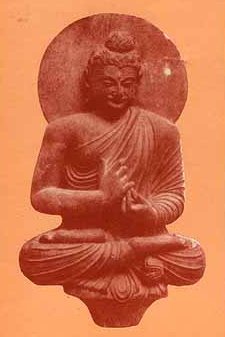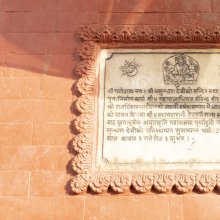Asada, Āsada, Asāda, Āsāda, Ashada: 12 definitions
Introduction:
Asada means something in Hinduism, Sanskrit, Buddhism, Pali, Marathi, Jainism, Prakrit. If you want to know the exact meaning, history, etymology or English translation of this term then check out the descriptions on this page. Add your comment or reference to a book if you want to contribute to this summary article.
Images (photo gallery)
In Hinduism
General definition (in Hinduism)
Source: archive.org: Vedic index of Names and SubjectsAsāda (असाद) refers to a “pedestrian”.—Sādin in the Atharvaveda denotes the ‘rider’ of a horse as opposed to asāda, ‘pedestrian’. An aśvasādin, ‘horse-rider,’ is known to the Vājasaneyi Saṃhitā. The Taittirīya Brāhmaṇa and the Ṛgveda itself contain clear references to horse-riding, while the Aitareya Āraṇyaka refers to mounting a horse sideways. Āśvalāyana knows sādya as a ‘riding horse’ opposed to vahya, a ‘draught animal.’
Languages of India and abroad
Pali-English dictionary
Source: Sutta: The Pali Text Society's Pali-English DictionaryĀsada, (ā + sad; cp. āsajja & āsādeti) — 1. approach, dealing with, business with (Acc.), concern, affair, means of acting or getting Vin. II, 195 = J. V, 336 (mā kuñjara nāgam āsado); M. I, 326 (metaṃ āsado = mā etaṃ āsado do not meddle with this, lit. , be not this any affair); J I 414 (cakkaṃ āsado you have to do with the wheel; interpreted as adj. in meaning patto = finding, getting); VI, 528 (interpreted as aṅkusa a hook, i.e. means of getting something).—2. (as adj.) in phrase durāsada hard to sit on, i.e. hard to get at, unapproachable, difficult to attack or manage or conquer Sn. p. 107 (cp. SnA 451); J. VI, 272; Vv 5016 (= anupagamanīyato kenaci pi anāsādanīyato ca durāsado VvA. 213); Miln. 21; Dpvs. V, 21; VI, 38; Sdhp. 384. (Page 114)

Pali is the language of the Tipiṭaka, which is the sacred canon of Theravāda Buddhism and contains much of the Buddha’s speech. Closeley related to Sanskrit, both languages are used interchangeably between religions.
Marathi-English dictionary
Source: DDSA: The Molesworth Marathi and English Dictionaryasaḍā (असडा).—m (asaḍaṇēṃ) A sudden and smart pull or fling or jerk (of a limb): also the pain following it. v dē, basa. Also a sudden catching up or snatching; a smart catching up or back (of a whip or cord), v dē. 2 A convulsive throe or quiver (as of a drowning, hanging, choking, or dying person): also the rising up and issuing forth of the last breath of such. v dē, yē. 3 A shock or blow; a loss or damage sustained (in trade, to a crop &c.) v basa.
--- OR ---
asaḍā (असडा).—a (a & saḍaṇēṃ) Unhusked; unbeaten in the mortar--rice &c. 2 fig. Undisciplined, untrained, unbroken in, unpolished.
Source: DDSA: The Aryabhusan school dictionary, Marathi-Englishasaḍā (असडा) [-ḍī, -डी].—a Unhusked; un- trained.
Marathi is an Indo-European language having over 70 million native speakers people in (predominantly) Maharashtra India. Marathi, like many other Indo-Aryan languages, evolved from early forms of Prakrit, which itself is a subset of Sanskrit, one of the most ancient languages of the world.
Sanskrit dictionary
Source: DDSA: The practical Sanskrit-English dictionaryAsāda (असाद).—a.
1) Ved. Not sitting; having no seat; Not mounted (on horse-back); असादा ये च सादिनः (asādā ye ca sādinaḥ) Av.11.1. 24.
2) Not becoming tired, unwearied; Raj. T.
--- OR ---
Āsāda (आसाद).—Ved. Cushion. सामासाद उद्गीथे उपश्रयः (sāmāsāda udgīthe upaśrayaḥ) Av.15.3.8.
Derivable forms: āsādaḥ (आसादः).
Source: Cologne Digital Sanskrit Dictionaries: Aufrecht Catalogus CatalogorumĀsaḍa (आसड) as mentioned in Aufrecht’s Catalogus Catalogorum:—son of Kaṭuka, wrote in 1192: Vivekamañjarī(jain). He composed a Commentary on Kālidāsa’s Meghadūta. Peters. 3, 102.
Source: Cologne Digital Sanskrit Dictionaries: Monier-Williams Sanskrit-English Dictionary1) Asāda (असाद):—[=a-sāda] mfn. not mounted on horseback, [Atharva-veda xi, 10, 24]
2) [v.s. ...] not becoming tired, unwearied, [Rājataraṅgiṇī]
3) Āsaḍa (आसड):—m. Name of the author of a [commentator or commentary] on [Meghadūta] (12th cent, [Apte’s The Practical Sanskrit-English Dictionary]D.).
4) Āsada (आसद):—[=ā-sada] [from ā-sad] m. approaching, meeting (See dur-).
5) Āsāda (आसाद):—[=ā-sāda] [from ā-sad] a m. a footstool, cushion, [Atharva-veda xv, 3, 8; Tāṇḍya-brāhmaṇa]
6) [from ā-sāda > ā-sad] an eating-room, kitchen, [Kauśika-sūtra]
7) b etc. See ā-√sad.
Source: DDSA: Paia-sadda-mahannavo; a comprehensive Prakrit Hindi dictionary (S)Āsāda (आसाद) in the Sanskrit language is related to the Prakrit words: Assāda, Āsaḍa, Āsāa.
[Sanskrit to German]
Sanskrit, also spelled संस्कृतम् (saṃskṛtam), is an ancient language of India commonly seen as the grandmother of the Indo-European language family (even English!). Closely allied with Prakrit and Pali, Sanskrit is more exhaustive in both grammar and terms and has the most extensive collection of literature in the world, greatly surpassing its sister-languages Greek and Latin.
Prakrit-English dictionary
Source: DDSA: Paia-sadda-mahannavo; a comprehensive Prakrit Hindi dictionaryĀsaḍa (आसड) in the Prakrit language is related to the Sanskrit word: Āsaḍa.
Prakrit is an ancient language closely associated with both Pali and Sanskrit. Jain literature is often composed in this language or sub-dialects, such as the Agamas and their commentaries which are written in Ardhamagadhi and Maharashtri Prakrit. The earliest extant texts can be dated to as early as the 4th century BCE although core portions might be older.
Kannada-English dictionary
Source: Alar: Kannada-English corpusAṣāḍa (ಅಷಾಡ):—
1) [noun] (rightly, ಆಷಾಢ [ashadha]) 1. the fourth month in the Indian calendar.
2) [noun] a long staff of Butea tree, carried by monks and celibate students.
3) [noun] (pl.) the twentieth and twenty first lunar constellations.
4) [noun] (astrol.) a person whose birth star belongs to either the twentieth or twenty first lunar constellation.
--- OR ---
Āṣāḍha (ಆಷಾಢ):—
1) [noun] the fourth month of Hindu (lunar and solar) calendar.
2) [noun] a staff of the tree Butea frondosa, held by the celibate students or sages.
3) [noun] ಆಷಾಡದ ಗಾಳಿ ಬೀಸಿಬೀಸಿಬಡಿವಾಗ, ಹೇಸಿ ನನ್ನಜೀವ ಹೆಂಗಸಾಗಬಾರದಿತ್ತೆ [ashadada gali bisibisibadivaga, hesi nannajiva hemgasagabaraditte]? āṣāḍada gaḷi bīsi bīsi baḍivāga hēsi nanna jīva heŋgasāgabārade the pine wishes herself a shrub when the axe is at her foot.
--- OR ---
Āsaḍa (ಆಸಡ):—[noun] = ಆಷಾಢ - [ashadha -] 1.
--- OR ---
Āsāḍa (ಆಸಾಡ):—[noun] the fourth month in the Hindu (solar and lunar) calendar.
Kannada is a Dravidian language (as opposed to the Indo-European language family) mainly spoken in the southwestern region of India.
See also (Relevant definitions)
Partial matches: A, Shada, Shata, Cata.
Starts with (+13): Acatai, Acatam, Acataranam, Asadacara, Asadacarin, Asadachara, Asadacharin, Asadadhyetar, Asadadhyetri, Asadagama, Asadagra, Asadagraha, Asadakhyati, Asadala, Asadalam, Asadalisu, Asadam, Asadana, Asadanem, Asadanushasana.
Ends with (+207): Abhippasada, Abhiprasada, Abhyasada, Accaprasada, Aggapasada, Aggapithaka Pasada, Akritaprasada, Alasada, Ambikaprasada, Ambuprasada, Amraprasada, Analasada, Anavasada, Angasada, Anuppasada, Apakshasada, Apasada, Appasada, Aprasada, Arshalingaprasada.
Full-text (+249): Ashadha, Asaa, Ashadhi, Assada, Ashadhaka, Ashadhabhava, Krishnadvadashi, Grishma, Dvirashadha, Shayanaikadashi, Savayasa, Ashadhabhu, Ambuvaci, Ashadhika, Asaliha, Nagapancami, Asaditimgalu, Ashada beru, Acatam, Carne asada.
Relevant text
Search found 62 books and stories containing Asada, Āsada, Asaḍā, Asāda, Āsāda, Āsaḍa, A-sada, A-sāda, Ā-sada, Ā-sāda, Ashada, Aṣāḍa, Ashadha, Aṣāḍha, Āṣāḍha, Āsāḍa; (plurals include: Asadas, Āsadas, Asaḍās, Asādas, Āsādas, Āsaḍas, sadas, sādas, Ashadas, Aṣāḍas, Ashadhas, Aṣāḍhas, Āṣāḍhas, Āsāḍas). You can also click to the full overview containing English textual excerpts. Below are direct links for the most relevant articles:
Rig Veda (translation and commentary) (by H. H. Wilson)
Brihat Samhita (by N. Chidambaram Iyer)
Chapter 7 - On the course of Mercury (budha-cāra)
Appendix 3 - List of 28 yogatārās (chief stars) of the constellations (nakṣatras)
The Skanda Purana (by G. V. Tagare)
Chapter 21 - Importance of Viṣṇu worship at Gomatī Tīrtha < [Section 4 - Dvārakā-māhātmya]
Chapter 36 - The Festival of the Lord’s Retiring to Sleep < [Section 2 - Puruṣottama-kṣetra-māhātmya]
Chapter 41 - Manifestation of Jalaśāyin < [Section 1 - Tīrtha-māhātmya]
The Coming of Ashadha < [May-June, 1929]
The Coming of ‘Ashadha’ < [April - June 1977]
The Time Factor in Meghasandesa < [January 1967]
The Garuda Purana (by Manmatha Nath Dutt)
Chapter LX - Discourses on the period of influences of the different planets with that of the sun < [Agastya Samhita]
Chapter CXX - The Rambha Trtiya Vratam < [Brihaspati (Nitisara) Samhita]
Chapter CXXI - The Caturmasyam Vratam < [Brihaspati (Nitisara) Samhita]
The Agni Purana (by N. Gangadharan)
